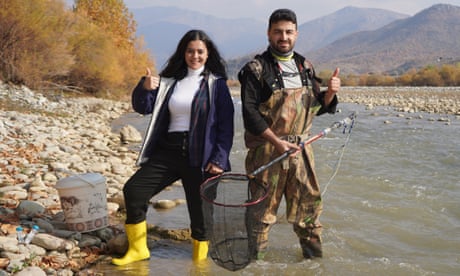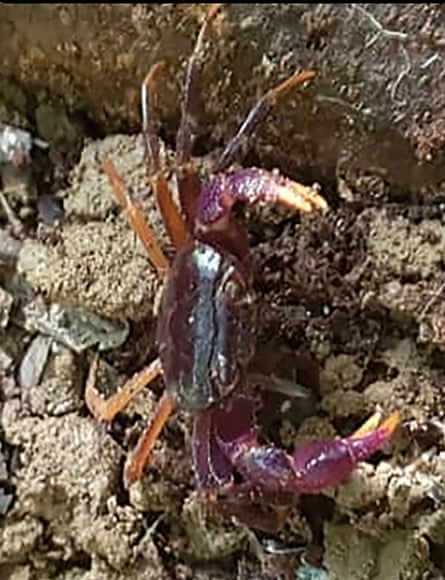The label on a specimen of Afzelius’s crab simply said ‘Sierra Leone’. But it was enough for an expedition to track it down along with another ‘lost’ freshwater crab

Afzelius's crab, one of the species rediscovered by an expedition to Sierra Leone earlier this year. The land-dwelling species had not been sighted since 1796.
Photograph: Pierre A Mvogo Ndongo/re:wild
The age of extinction
Graeme Green
The age of extinction
Graeme Green
THE GUARDIAN
Thu 17 Nov 2022
Tracking down rare species believed to be extinct is never easy, but when Pierre A Mvogo Ndongo travelled to Sierra Leone in January 2021 to search for “lost” species of land-dwelling crabs, the feeling of looking for a needle in a haystack was particularly powerful due to the size of the “haystack”. For one of the species, Afzelius’s crab (Afrithelphusa afzelii), last seen in 1796, the only clue was the label on a specimen that simply said: “Sierra Leone.”
Mvogo Ndongo’s expedition was primarily looking for the rainbow-coloured, land-dwelling Sierra Leone crab Afrithelphusa leonensis, lost to science for 65 years and thought to be possibly extinct – one of the species on wildlife charity Re:wild’s 25 “most wanted lost species” list. He also hoped – but never expected – to find, Afzelius’s crab (Afrithelphusa afzelii).

Lost and found: stroke of luck that helped rediscover tiny ‘superhero’ fish
Both species are land-dwelling crabs that live in burrows on the rainforest floor. “Most freshwater crabs in Africa live in rivers, streams and lakes,” says Mvogo Ndongo, a lecturer at the Institute of Fisheries and Aquatic Sciences at the University of Douala in Cameroon.
“The species of interest belong to a unique Afrotropical family that includes members that can breathe air, which has enabled them to conquer more obscure habitats in the rainforest, often far away from permanent water sources … [They] are extremely colourful compared to their river-dwelling cousins, and they can climb trees, live in rock crevices, dig in marshes, or make burrows in the forest floor,” he says.
Sierra Leone, Guinea and Liberia are the only countries in Africa where these crabs occur, and there are only five species known, he adds.
For three weeks, working alongside local communities in Sierra Leone’s northern, southern and south-eastern provinces, Mvogo Ndongo found only false leads and frustration.
While many scientific discoveries (and rediscoveries) are helped by the rigorous, extensive notes of other scientists who’ve gone before, that wasn’t the case here.
“Afrithelphusa afzelii hadn’t been seen for 225 years and literally the only information on where to look for it was on the specimen label as ‘Sierra Leone’ – a very non-specific locality indeed,” Mvogo Ndongo says. “We deduced it must have been collected within walking distance of Freetown, so we began our surveys in the forest in that vicinity. But this was still too vague.
The team asked local people if they had seen any crabs living on land away from rivers and streams until encountering someone who could help. “We struck lucky – one man took us to his farm on the edge of the forest where, after intense searching, the species was rediscovered,” he says.
The day after finding Afzelius’s crab, Mvogo Ndongo travelled to the forests of Sugar Loaf Mountain, south of Freetown. With time running out due to an impending Covid-19 lockdown, he searched around Guma Lake, based on a local tip.
Deep in the forest, he finally found the Sierra Leone crab. The crabs were living in burrows so deep that Mvogo Ndongo and his team had to carefully excavate them using picks and machetes, before cleaning soil from the crabs to reveal the colourful crustaceans – the first living specimens seen since 1955.
 \
\
Tracking down rare species believed to be extinct is never easy, but when Pierre A Mvogo Ndongo travelled to Sierra Leone in January 2021 to search for “lost” species of land-dwelling crabs, the feeling of looking for a needle in a haystack was particularly powerful due to the size of the “haystack”. For one of the species, Afzelius’s crab (Afrithelphusa afzelii), last seen in 1796, the only clue was the label on a specimen that simply said: “Sierra Leone.”
Mvogo Ndongo’s expedition was primarily looking for the rainbow-coloured, land-dwelling Sierra Leone crab Afrithelphusa leonensis, lost to science for 65 years and thought to be possibly extinct – one of the species on wildlife charity Re:wild’s 25 “most wanted lost species” list. He also hoped – but never expected – to find, Afzelius’s crab (Afrithelphusa afzelii).

Lost and found: stroke of luck that helped rediscover tiny ‘superhero’ fish
Both species are land-dwelling crabs that live in burrows on the rainforest floor. “Most freshwater crabs in Africa live in rivers, streams and lakes,” says Mvogo Ndongo, a lecturer at the Institute of Fisheries and Aquatic Sciences at the University of Douala in Cameroon.
“The species of interest belong to a unique Afrotropical family that includes members that can breathe air, which has enabled them to conquer more obscure habitats in the rainforest, often far away from permanent water sources … [They] are extremely colourful compared to their river-dwelling cousins, and they can climb trees, live in rock crevices, dig in marshes, or make burrows in the forest floor,” he says.
Sierra Leone, Guinea and Liberia are the only countries in Africa where these crabs occur, and there are only five species known, he adds.
For three weeks, working alongside local communities in Sierra Leone’s northern, southern and south-eastern provinces, Mvogo Ndongo found only false leads and frustration.
While many scientific discoveries (and rediscoveries) are helped by the rigorous, extensive notes of other scientists who’ve gone before, that wasn’t the case here.
“Afrithelphusa afzelii hadn’t been seen for 225 years and literally the only information on where to look for it was on the specimen label as ‘Sierra Leone’ – a very non-specific locality indeed,” Mvogo Ndongo says. “We deduced it must have been collected within walking distance of Freetown, so we began our surveys in the forest in that vicinity. But this was still too vague.
The team asked local people if they had seen any crabs living on land away from rivers and streams until encountering someone who could help. “We struck lucky – one man took us to his farm on the edge of the forest where, after intense searching, the species was rediscovered,” he says.
The day after finding Afzelius’s crab, Mvogo Ndongo travelled to the forests of Sugar Loaf Mountain, south of Freetown. With time running out due to an impending Covid-19 lockdown, he searched around Guma Lake, based on a local tip.
Deep in the forest, he finally found the Sierra Leone crab. The crabs were living in burrows so deep that Mvogo Ndongo and his team had to carefully excavate them using picks and machetes, before cleaning soil from the crabs to reveal the colourful crustaceans – the first living specimens seen since 1955.
 \
\The Sierra Leone crab (Afrithelphusa leonensis), which is one of Re:wild’s 25 most wanted species. Photograph: Pierre A. Mvogo Ndongo/re:wild
Alongside the rediscovered Sierra Leone crab and Afzelius’s crab, two new species of freshwater crabs were also found. However, the crabs’ habitats are now threatened by the destruction of the forest for agriculture and for firewood.
“These discoveries are bittersweet because the joy of discovering lost species is mixed with the realisation that, while not extinct, they’re on the edge of extinction, and that urgent conservation interventions will be required to protect these species in the long term,” says Neil Cumberlidge, a professor in the Department of Biology at Northern Michigan University, who collaborated with Mvogo Ndongo on the expedition.
Now scientists know the crabs are there, it is hoped they can be protected.
“The new data generated by the expedition will allow us to reassess the red list status of each of these species this will probably be ‘critically endangered’, ie close to extinction,” says Cumberlidge. “The next step is to devise a species action plan and implement protective measures in the field with Sierra Leone conservationists to save these species from extinction.”
Find more age of extinction coverage here, and follow the Guardian’s biodiversity reporters Phoebe Weston and Patrick Greenfield on Twitter for all the latest news and features
Alongside the rediscovered Sierra Leone crab and Afzelius’s crab, two new species of freshwater crabs were also found. However, the crabs’ habitats are now threatened by the destruction of the forest for agriculture and for firewood.
“These discoveries are bittersweet because the joy of discovering lost species is mixed with the realisation that, while not extinct, they’re on the edge of extinction, and that urgent conservation interventions will be required to protect these species in the long term,” says Neil Cumberlidge, a professor in the Department of Biology at Northern Michigan University, who collaborated with Mvogo Ndongo on the expedition.
Now scientists know the crabs are there, it is hoped they can be protected.
“The new data generated by the expedition will allow us to reassess the red list status of each of these species this will probably be ‘critically endangered’, ie close to extinction,” says Cumberlidge. “The next step is to devise a species action plan and implement protective measures in the field with Sierra Leone conservationists to save these species from extinction.”
Find more age of extinction coverage here, and follow the Guardian’s biodiversity reporters Phoebe Weston and Patrick Greenfield on Twitter for all the latest news and features
No comments:
Post a Comment